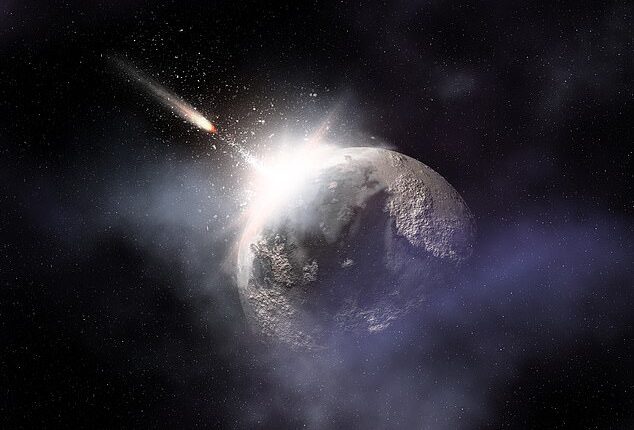The world breathed a sigh of relief when NASA confirmed the city-killer asteroid 2024 YR4 was no longer likely to hit Earth.
But scientists now warn that the threat posed by this deadly space rock is far from over.
Astronomers say that the 60-metre asteroid still has a 4.3 per cent chance of slamming into the moon on December 22, 2032.
This collision would shower Earth with a wave of shrapnel that could wreak havoc on satellites in orbit.
According to simulations created by Dr Paul Wiegert, of the University of Western Ontario, the asteroid could hit the moon at over 29,000mph (46,800 kmph), carving out a 0.6 mile-wide crater in the biggest lunar impact in the last 5,000 years.
If the asteroid hits in the right place, Earth’s gravity might funnel between 10 and 30 per cent of the ejected material directly towards our planet.
And this could have devastating consequences for the thousands of satelites in low-Earth orbit.
Dr Wiegert’s calculations show that the shrapnel could cause up to a decade’s worth of damage in just days.

Scientists warn that the city-killer asteroid 2024 YR4 could hit the moon and unleash a devastating wave of shrapnel (stock image)

The asteroid 2024 YR4 (artist’s impression) was first spotted in 2024. At its peak, scientists predicted the space rock had a 3.1 per cent chance of hitting Earth, but this has now fallen to 0.00081 per cent

The asteroid still has a 4.3 per cent chance of hitting the moon. This collision would release tonnes of lunar debris (illustrated) into space
2024 YR4 was first discovered in December 2024 and quickly caused concern among astronomers as the chances of an impact with Earth rose.
At its peak, astronomers predicted that the asteroid had a 3.1 per cent chance of hitting Earth in 2032.
While emergency observations from the James Webb Space Telescope (JWST) soon confirmed that the asteroid would miss Earth, it also revealed a surprisingly high probability of a lunar impact.
At around 60 metres wide, the city-killer’s impact would unleash a blast 500 times larger than the atomic bomb dropped on Hiroshima.
On the moon, the absence of an atmosphere to slow the space rock’s approach could mean an even bigger impact.
By simulating 10,000 possible impact scenarios, Dr Wiegert found that this would eject around 10,000 tonnes of material between 0.1 to 10 millimetres in size.
How much of this material travels towards us depends on where the asteroid lands, but the simulations suggest a scenario in which up to 10 per cent is delivered.
This would lead to the Earth experiencing rates of particle impacts between 10 and 1,000 times higher than normal.

By simulating 10,000 different scenarios, scientists found the impact pathway along the moon’s southern hemisphere, shown here in yellow

At 60 metres across, 2024 YR4 has the potential to unleash a blast 500 times larger than the atomic bomb dropped on Hiroshima, this would create a 0.6-mile-wide (1km) crater on the moon
Dr Wiergert told the New Scientist: ‘We were a little bit surprised at the possibility of there being a substantial amount of material at the Earth.
‘Intuitively, the Earth is actually quite a small target when seen from the moon, and so your intuition is that not very much material would actually hit the Earth, but it turns out that the Earth’s gravity can focus that material under certain conditions.’
None of this material is likely to make it through Earth’s atmosphere, but it would create a severe problem for satellites in low-Earth orbit and other spacecraft.
Dr Wiegert points out that this debris could even affect the operations of lunar-orbiting spacecraft such as NASA’s planned Lunar Gateway.
Any debris that doesn’t escape orbit would rain back down on the moon, damaging landers, rovers, and even threatening the lives of astronauts in the Artemis program.
However, this would be particularly dangerous for the large satellite constellations, such as SpaceX’s Starlink satellites, currently in orbit.
In a preprint paper, submitted to the American Astronomy Society Journals, Dr Wiegert predicts that a lunar impact could lead to ‘hundreds to thousands of impacts from mm-sized debris’.
If lots of satellites are hit at once, these impacts can easily combine to cause more widespread disruption.

Asteroid 2024 YR4 is about the same size as the Tunguska asteroid, which caused the largest impact event in recorded history when it shot through Earth’s atmosphere in 1908, flattening 830 square miles (2,150 square km) of forest (pictured)

The cloud of debris released (possible scenarios shown in red, blue, yellow, and green) will travel towards Earth and cause hundreds or thousands of collisions with satellites

This would be particularly dangerous for satellite constellations such as SpaceX’s Starlink (pictured), as even small collisions could lead to widespread disruption
Professor Burchell, a space scientist from the University of Kent, told MailOnline: ‘A lot of satellites failing at once is worse than occasional failures spread over a decade, as the latter can be more readily managed without stretching resources.
‘If all at once, it would risk temporarily overwhelming the response with short-term loss of provision.’
The impact from lunar debris would typically be small, but could cause problems that cannot easily be repaired.
Research conducted by Professor Mark Burchell suggests that debris just one millimetre across is large enough to damage solar cells, sever cables, and even penetrate astronaut space suits.
Pieces up to 10 millimetres in diameter are large enough to break into the interior of spacecraft and cause ‘increasing damage’.
Professor Burchell told MailOnline: ‘If a sensor is damaged, or a piece of cabling, the satellite as a whole is still there, but may lose performance or some essential capability.
‘Think of this as the difference between a car crash which wrecks your car and getting a chip on the windscreen. The former is clearly bad, but a chip? It is liveable in most cases, but may fail.’








